In this guide, I’ll walk you through how to make Nasi Lemak, sambal, anchovies, peanuts, egg, and cucumber; with both stovetop and rice cooker options for making the rice.

Nasi Lemak has been named the national dish of Malaysia, and you’ll find it everywhere from roadside carts to fancy restaurants.
Traditionally eaten for breakfast but enjoyed at any time of day, nasi lemak is one of those dishes Malaysians never get tired of.
Simple yet complete. Fragrant coconut rice, spicy sambal, crispy anchovies, peanuts, hard-boiled egg, and sliced cucumber. Together, those flavors hit every note: sweet, spicy, salty, and savory.
Growing up in Malaysia, one of my favorite childhood memories was buying little banana-leaf packets of Nasi Lemak from my school canteen. Each packet cost only 50 sen back then (RM0.50, which was about 20 US cents in the early 1990s). While living abroad, this was the dish I missed and craved the most.
Now, making nasi lemak at home isn’t hard, but it does take a bit of patience and planning as there are several moving parts.
The good news is that many of the components can be made ahead, and I’ve included a suggested preparation sequence here in this post.
How to Cook Nasi Lemak (Stovetop Method)
If you have cooked white rice on a stovetop before, making nasi lemak will feel quite familiar. You’re basically just adding a few extra aromatics for flavor.
Pour 2 cups of uncooked white rice into a pot. Rinse three to four times or until the water runs almost clear.
Add ½ cup coconut milk and 2 ½ cups of water to the rice.
Tie 2 pandan (screwpine) leaves into a knot, and add them to the pot. If you are not able to find fresh pandan leaves, you should be able to get frozen pandan leaves at your local Asian supermarket.
Add 1 knob of ginger (peeled; approximately 1 - 2 inches), and 1 teaspoon of salt.
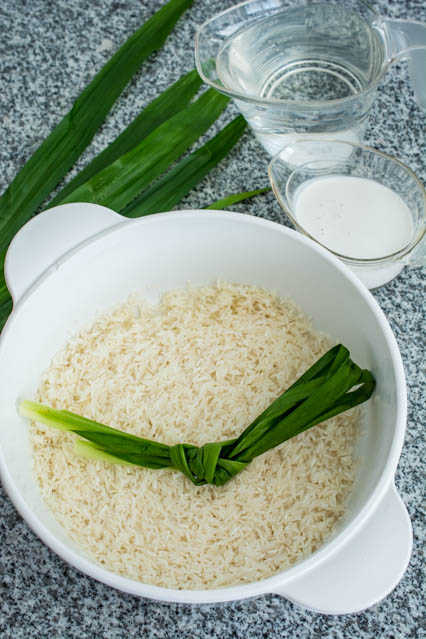
Place the pot on the stove over high heat to bring it to a boil (uncovered).
When it reaches a rolling boil, reduce the heat to medium to bring it down to a simmer.
After most of the liquid has been absorbed, you’ll notice little “craters” forming on the surface of the rice. That’s your cue to put the lid on.
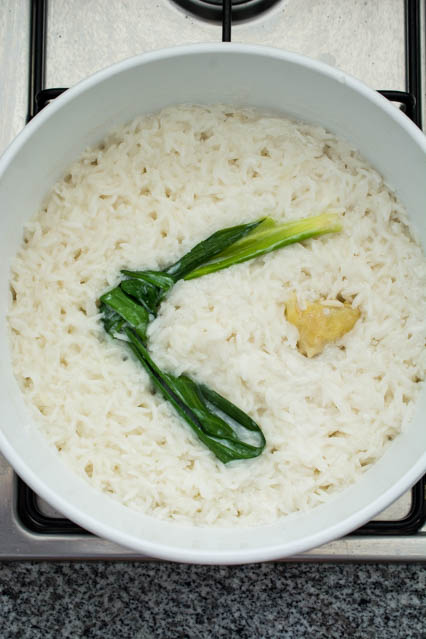
Let it bubble for just a few seconds more, then turn off the heat and leave the lid on to finish steaming (it will take about 15 more minutes). No peeking!
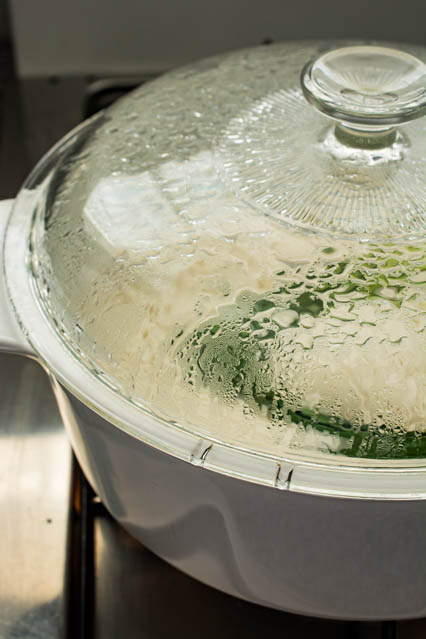
When the rice is done, open the lid and pour in another ½ cup of coconut milk along with a tablespoon of sugar.
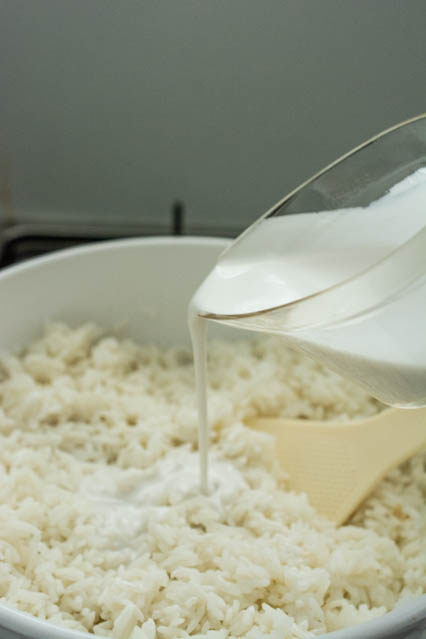
Stir it through the rice while it’s still hot, then cover the pot again for 5 minutes to let the flavors absorb.
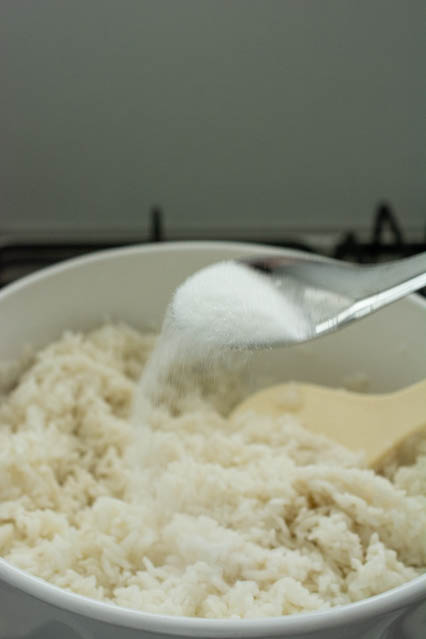
This final step gives the rice its signature richness, though you can skip it if you prefer a lighter coconut flavor.
How to Cook Nasi Lemak in a Rice Cooker
Using a rice cooker makes nasi lemak even easier!
Rinse 2 cups of uncooked white rice three or four times until the water is less cloudy.
Drain off as much water as you can, then add ½ cup of coconut milk. Top up with water until it reaches the “2-cup” line inside your rice cooker pot.
Tie two pandan leaves into a knot and add them in along with a peeled knob of ginger (about 1–2 inches) and a teaspoon of salt.
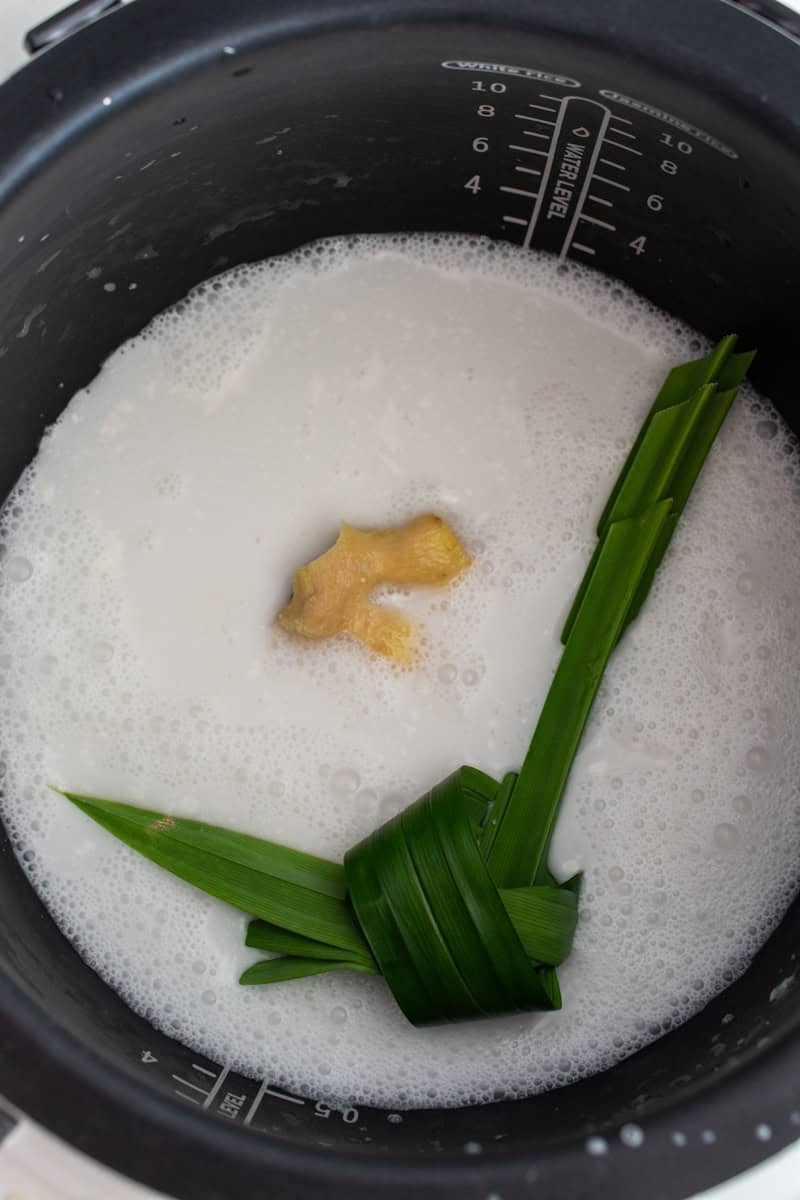
Switch on the rice cooker and let it do the work. Once it clicks over to “warm” or finishes cooking, open the lid and stir in another ½ cup of coconut milk, along with a tablespoon of sugar.
Give it a good mix, then close the lid and let the rice sit for about 5 minutes to absorb all that extra flavor.
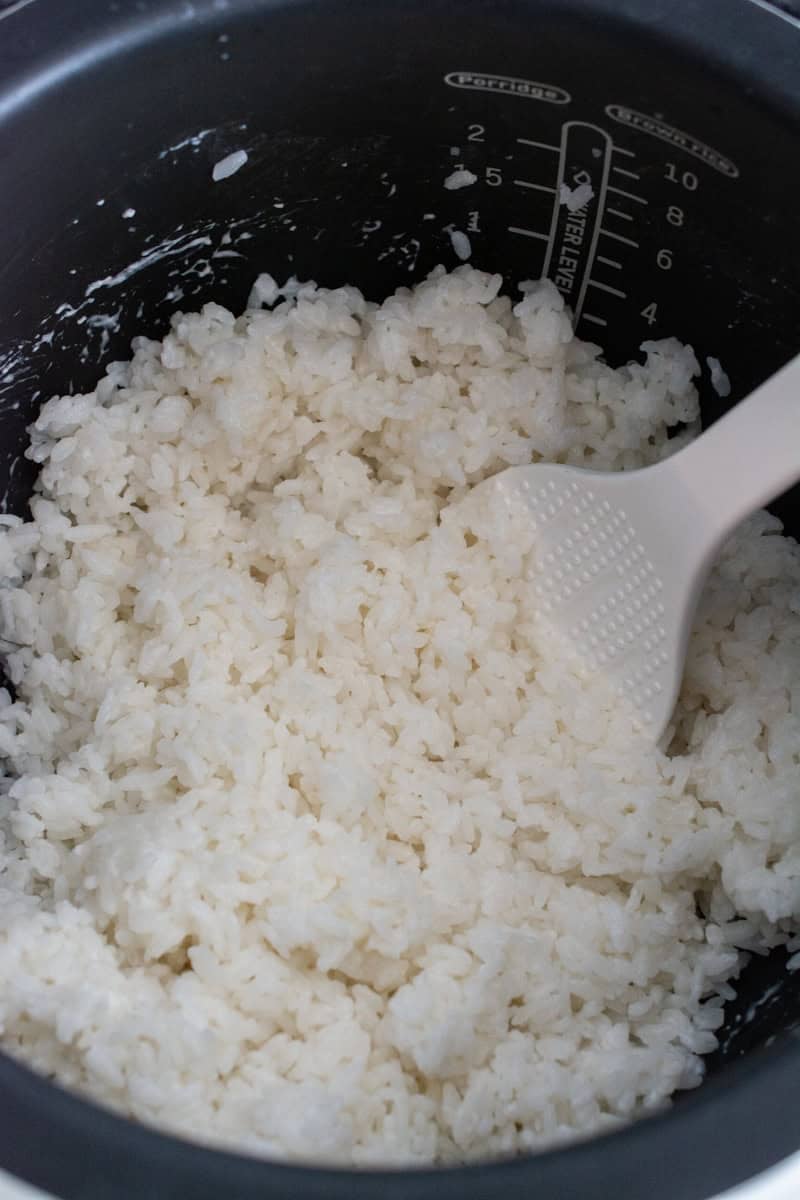
Sambal Recipe for Nasi Lemak
No nasi lemak is complete without sambal! This spicy, tangy chili paste is what ties the whole dish together.
While the sambal is the signature condiment, nasi lemak can also be quite versatile. You’ll often see it served with other spicy sauces/dishes such as Rendang or Ayam Masak Merah.
By the way, Nasi Lemak also pairs extremely well with Tamarind Shrimp!
To make a basic sambal, rinse 10–15 dried red chilies, then soak them in warm water for about 15 minutes until softened. For a less-spicy sambal, remove the seeds before soaking.
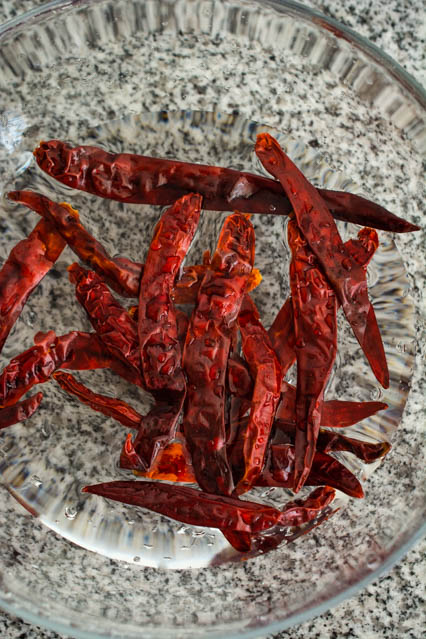
Would you like to save this?
At the same time, soak 1 tablespoon of tamarind paste in 1 ½ cups of warm water.
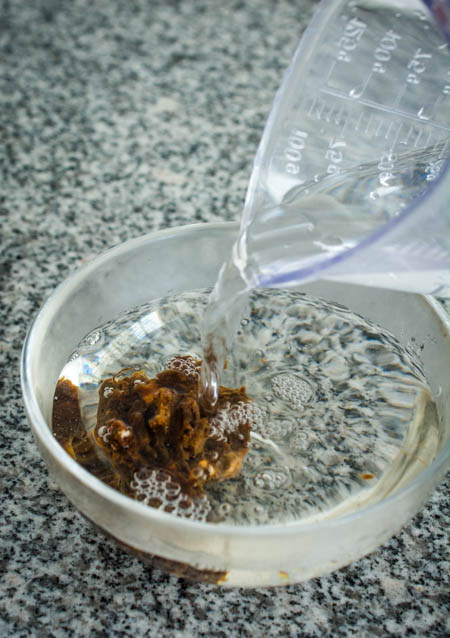
Once softened, press the pulp with your fingers to release the juice, then strain it through a sieve, pressing with a spoon to extract as much liquid as possible. Discard the pulp.
Place the softened chilies in a food processor along with two small shallots and two cloves of garlic.
If you have access to it, add 1 teaspoon of belacan. This is optional but highly recommended for authentic flavor.
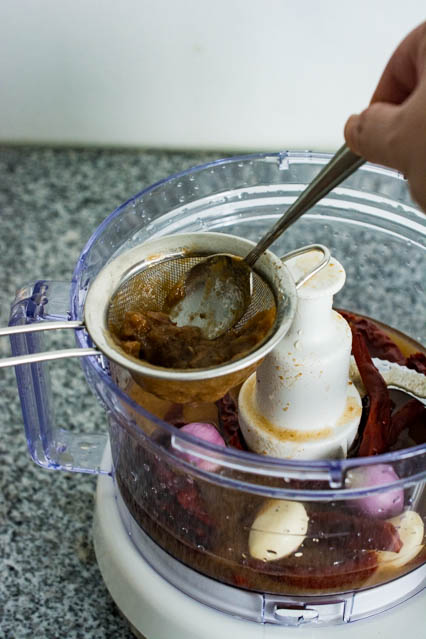
Pour in the tamarind water and blend everything into a smooth paste.
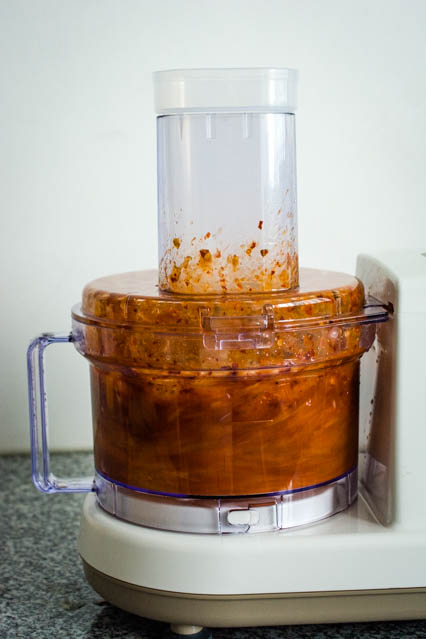
Heat 2 tablespoons of cooking oil in a wok over medium heat.
Add ½ an onion (sliced) to the wok, and sauté until soft.
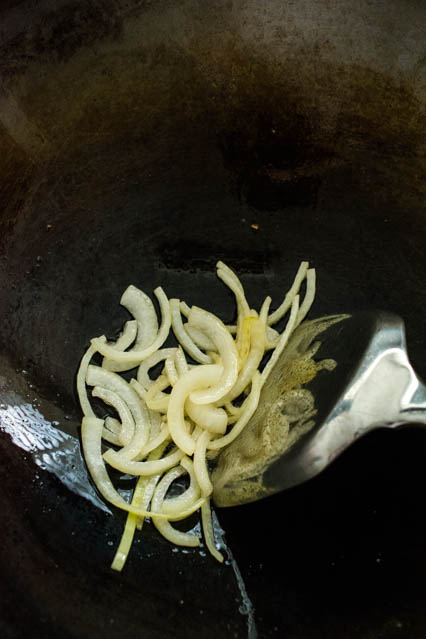
Stir in the chili paste, followed by a tablespoon of brown sugar.
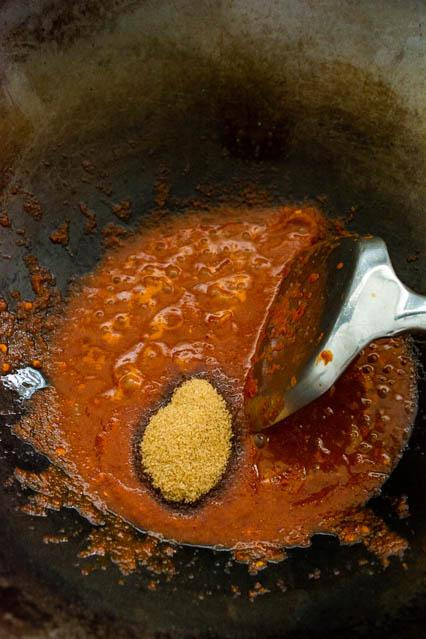
Let it cook down until it thickens (this will take a few minutes), tasting as you go. Adjust with more sugar or salt to balance the flavors.
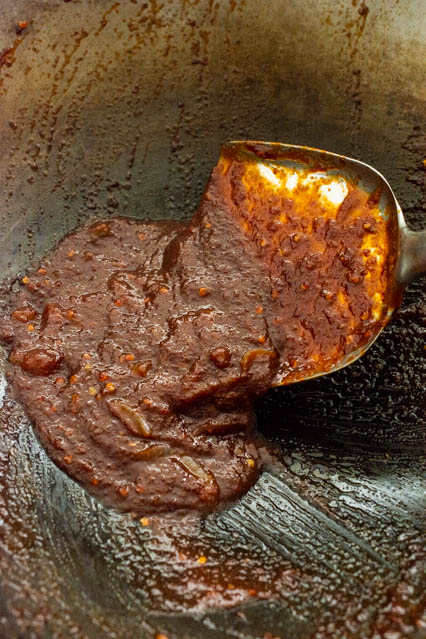
The sambal should be spicy and fiery (the kind that makes you sweat a little but keeps you coming back for more!), savory, and just a little sweet. The perfect match for that rich coconut rice.
Traditional Nasi Lemak Toppings
What makes nasi lemak such a complete meal isn’t just the coconut rice and sambal, but the toppings that balance everything out. The traditional set includes sliced cucumber, hard-boiled egg, crunchy peanuts, and crispy fried anchovies (ikan bilis).
You could use store-bought roasted peanuts, but I highly recommend frying your own raw red skin peanuts for that authentic touch.
Heat enough oil in your wok to deep-fry the peanuts. Fry them for just a few minutes, then remove them from the wok using a spider skimmer, then place the peanuts on paper towels. Sprinkle salt over the peanuts while they are still warm.
To prepare the anchovies, simply deep-fry approximately 1 cup of dried anchovies. You can find dried anchovies in most Asian supermarkets. I would recommend the small to medium-sized anchovies. Use a spider skimmer to remove the anchovies from the oil when they are golden brown.
Hard-boiled eggs are usually halved and served on the side. Fresh cucumber slices add a cool, refreshing contrast to the spicy sambal.
For a little extra crunch, you can also top your nasi lemak with crispy fried shallots.
Step-by-Step Nasi Lemak Preparation Sequence
Nasi lemak has several components, so having a clear plan makes the process much easier and less stressful.
Here’s the sequence I recommend if you’re making everything at one go:
- Start the rice: Wash and prepare the rice, then set it on the stove or in your rice cooker.
- Boil the eggs: Place eggs in a small pot, cover with water, and bring to a boil.
- Soak the chilies and tamarind: Rinse the dried red chilies and soak them in warm water. Soak the tamarind paste in a separate bowl.
- Prep the aromatics: Peel two shallots and two cloves of garlic. Slice two more shallots and one onion.
- Heat the oil: Get the wok ready for deep-frying. You'll want to use medium-high heat.
- Let the eggs finish cooking: Once the water for the eggs is boiling, turn off the heat and leave the eggs in the hot water to finish cooking.
- Check the rice: If cooking on the stovetop, cover the pot once the water has mostly absorbed.
- Fry the toppings: Deep-fry the peanuts, season with salt, then fry the shallots. Follow with the anchovies until golden and crisp.
- Blend the sambal: Place the soaked chilies, tamarind water, shallots, and garlic in a food processor. Blend until smooth.
- Cook the sambal:Remove excess oil from the wok (leave about 2 tablespoons), then cook the sambal paste with onion and brown sugar.
- Finish the rice: Stir in the additional coconut milk and sugar, then keep it covered until ready to serve.
- Prepare the fresh toppings: Slice the cucumber and cut the hard-boiled eggs in half.
- Ready to serve!
Make-Ahead Tips for Nasi Lemak
If you’d like to spread out the prep over a few days, several components of nasi lemak keep well, which makes it easy to make even on a busy weeknight. It doesn't have to be a weekend project.
The sambal and hard-boiled eggs can be stored in the fridge for up to a week. Fried peanuts will stay fresh in an airtight container for up to a month in the fridge, or about two weeks at room temp.
Anchovies (ikan bilis) are best fried on the day you plan to serve them, so they stay crispy.
💡 Pro Tips for the Best Nasi Lemak
Use pandan leaves if you can. They give the rice its signature aroma. If you can’t find them fresh, frozen pandan will work.
Make the sambal a day ahead. The flavors will deepen overnight, giving you a richer, more balanced chili paste.
Chill the cucumber. Keep the sliced cucumber in the fridge until just before serving. They really help to counter the spiciness of the sambal.
Serve on banana leaf. The warm rice picks up a light, earthy scent from the banana leaf. Subtle, but makes the experience even more authentic.
Frequently Asked Questions
Long-grain white rice, such as jasmine, works best for this recipe. It stays fluffy while soaking up the coconut milk and aromatics. Shorter-grain rice (like sushi rice) tends to get a little too sticky and gummy.
Pandan gives Nasi Lemak its signature fragrance, but if you can’t find fresh or frozen pandan leaves, you can just omit them. The rice will still taste delicious with just the coconut milk, ginger, and salt.
The heat mainly comes primarily from the dried chilies. If you want a milder sambal, remove most of the seeds before soaking. You can also mix in fresh red chilies with the seeds removed. They add brightness and color without too much heat.
Sure thing! Just skip the anchovies and belacan (shrimp paste) in the sambal. You can serve the rice with vegetarian-friendly sides like fried tempeh or tofu.
The rice and sambal will keep in the fridge for about 3–4 days. Hard-boiled eggs can be stored in the fridge for up to a week. Store peanuts in an airtight container for up to two weeks at room temperature (or longer in the fridge). For the best crunch, fry the anchovies fresh on the day you plan to serve them.
Yup! As long as there’s not too much sambal mixed in, the rice will hold up well and even take on more flavor as it sits. Just be mindful of the ratio. Too much sambal can make the rice too wet and be too overpowering. Store it in an airtight container in the fridge, then reheat in the microwave before serving.
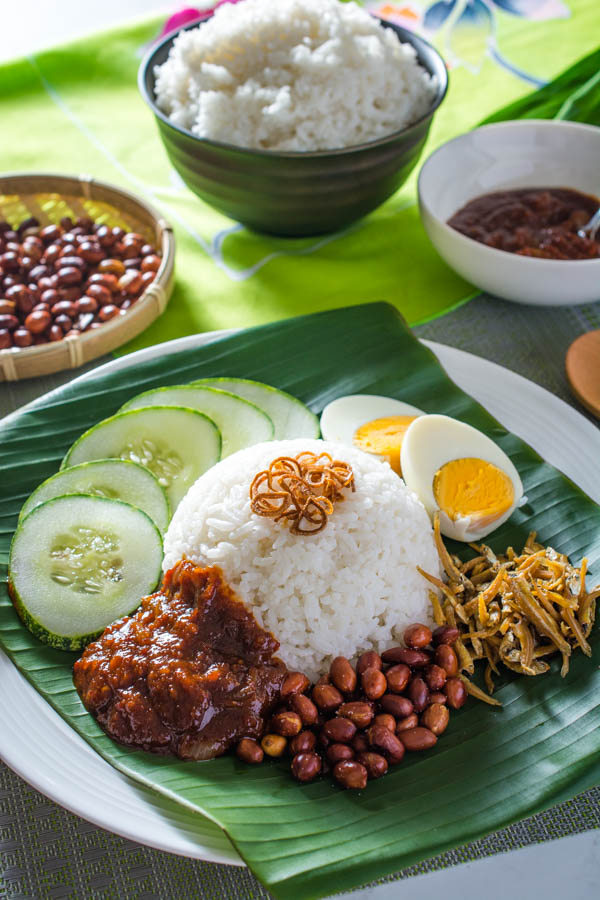

Malaysian Nasi Lemak (Coconut Rice with Sambal)
Ingredients
Nasi Lemak (rice)
- 2 cups uncooked white rice
- 1 cup coconut milk divided
- 2 ½ cups water
- 2 pandan screwpine leaves, tied into a knot
- 1 knob ginger 1-2 inches, peeled
- 1 teaspoon salt
- 1 tablespoon sugar
Sambal
- 10 - 15 dried red chilies seeds removed for milder sambal
- 1 tablespoon tamarind paste
- 2 shallots
- 2 cloves garlic
- 1 teaspoon belacan optional
- 2 tablespoons cooking oil
- ½ onion sliced
- 1 tablespoon brown sugar
Other toppings for Nasi Lemak
- 2 hard-boiled eggs halved
- ½ cucumber sliced
- 1 cup raw red skin peanuts
- ½ teaspoon salt
- 1 cup dried anchovies (ikan bilis)
- ¼ cup crispy shallots for garnish optional
- cooking oil for deep-frying
Instructions
Stovetop Method for Nasi Lemak Rice
- Rinse the rice 3–4 times until the water is clear.
- Add ½ cup coconut milk, 2 ½ cups water, pandan leaves, ginger, and salt to the pot.
- Bring to a boil uncovered over high heat. Once boiling, reduce to medium and let it simmer.
- When the liquid has mostly absorbed and small “craters” appear on the rice surface, cover with a lid.
- Let it steam for a few seconds, then turn off the heat. Leave covered for 15 minutes (no peeking!).
- Stir in the remaining ½ cup coconut milk and sugar, mix well, then cover again for 5 minutes before serving.
Rice Cooker Method for Nasi Lemak Rice
- Rinse the rice 3–4 times until the water is clear. Drain well.
- Add ½ cup coconut milk, then fill with water up to the “2-cup” line on your rice cooker.
- Add pandan leaves, ginger, and salt. Cook as you normally would.
- When the rice cooker switches to “warm,” stir in the remaining ½ cup coconut milk and sugar.
- Close the lid and let it sit for 5 minutes before serving.
For the Sambal
- Soak dried chilies in warm water for 15 minutes.
- Soak tamarind paste in 1 ½ cups warm water for 15 minutes, then squeeze pulp to release juice. Strain and discard pulp.
- Blend softened chilies, shallots, garlic, belacan (if using), and tamarind water into a smooth paste.
- Heat oil in a wok over medium heat. Sauté sliced onion until soft.
- Stir in chili paste and brown sugar. Simmer until thickened, adjusting sugar and salt to taste.
Fried Peanuts
- Heat oil in a wok over medium-high heat.
- Fry peanuts for about 2 minutes until golden.
- Remove with a skimmer and drain on paper towels. Sprinkle with salt while warm.
Crispy anchovies:
- Deep fry the dried anchovies for about 2 minutes or until crispy. They should be a very light golden brown color.
- Remove with a skimmer and drain on paper towels.







Sharmila says
Hi Charmaine, Looking for the Lemak ratio for the rice today and found you!!! Blessings!
Char says
Hi Sharmila!!! What a nice surprise! 🙂 I'm so glad you found this recipe. I hope you enjoy it. Take care!